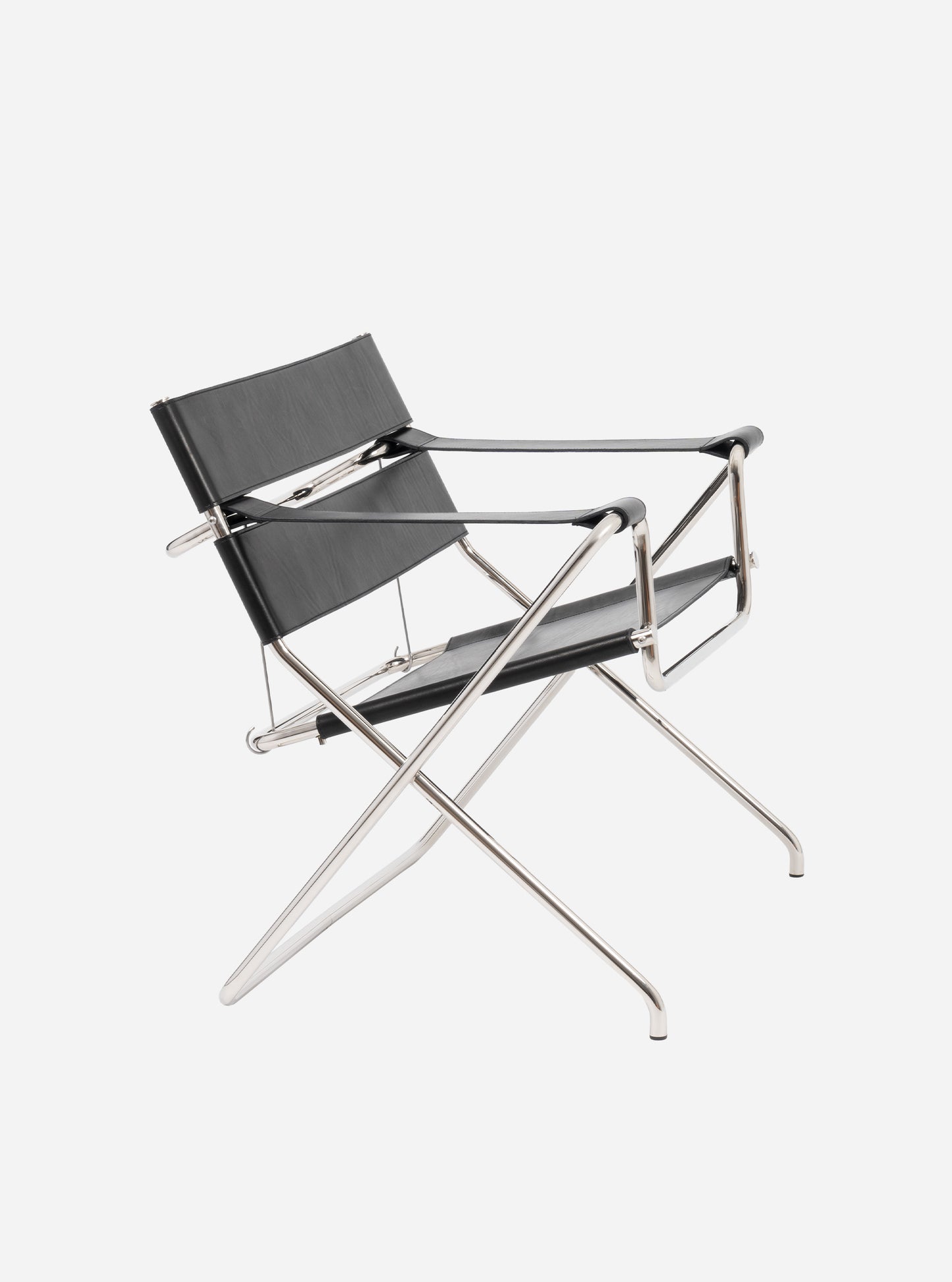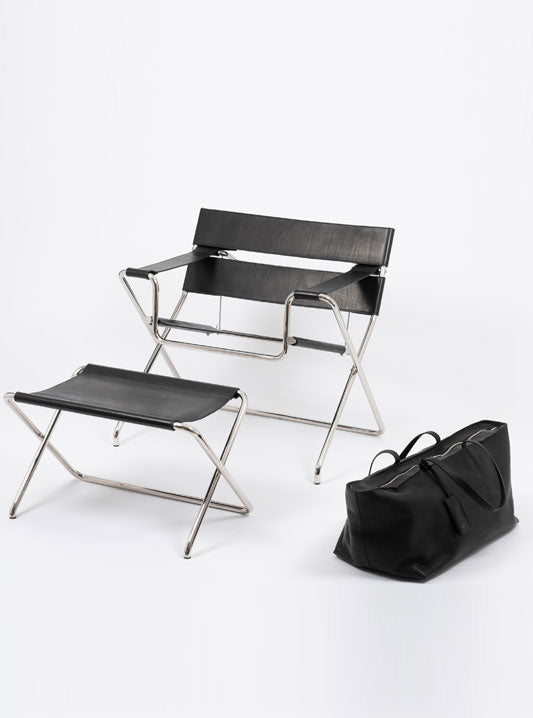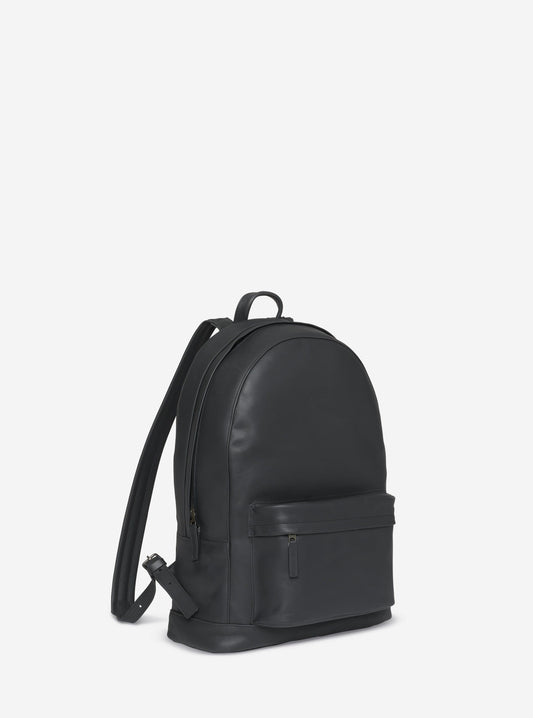PB 0110 x TECTA D4 Armchair Black
PB 0110 x TECTA D4 Armchair Black
FOUR WEEKS DELIVERY TIME
Tecta, a German family business in its fourth generation, is driven by a passion for examining, preserving, and advancing the best ideas of modernism – inspired by the Bauhaus in Weimar and Dessau. Beautifully situated amidst vast meadows, the company blends traditional craftsmanship with innovative design, showcasing works by design icons such as Walter Gropius, Mies van der Rohe, and Marcel Breuer. Our collaboration is based on shared values, a clear ethos and an unwavering commitment to quality.
A sense of beauty and functionality defines many of Marcel Breuer's designs, especially the D4 (formerly B4). The foldable tubular steel club chair with strap upholstery, designed in 1926/27, was originally marketed for ships, sports fields, and gardens. Light, springy, and modern, it continues to embody functional design to this day. In the 1970s, Axel Bruchhäuser, the then-owner of Tecta, rediscovered the design and convinced Breuer to bring it back into production. Breuer was delighted, calling its rediscovery “like a long-forgotten dream.”
The D4 represents the ultimate reduction to essentials: foldable, easy to store, and transportable. With its economical use of tubular steel and the elimination of side straps, it is not only more material-efficient but also offers enhanced seating comfort. In 1980, the D4 was added to the permanent collection of the MoMA in New York.
- The chair is foldable to a width of 35cm.
- Tecta sources the tubular steel from the Rhineland, and the high-gloss chrome plating is carried out in Bavaria in compliance with German environmental regulations. Assembly takes place in Lauenförde, Germany, at Tecta's headquarters.
- Vegetable-tanned leather from a family-run tannery in Germany that has been producing high-quality leather since 1888.
- The perfection of construction and detail. Of course, we primarily associate the Bauhaus master Marcel Breuer with a material: tubular steel. And a principle: the cantilever chair, which served as the ignition for modern furniture design. ""The liberation of humans from rigid seating gave way to liberation onto suspended seating. The cantilever chair became a symbol of the times."" But by reducing Marcel Lajos (""Lajkó"") Breuer (1902-1981) to this, we do not do him justice. The designer actually engaged in ""essence research"": What should, what can modern furniture achieve today was the question of the Bauhaus. In 1925, Breuer was appointed as the head of the furniture workshop in Dessau as a ""young master."" Already the year before, he formulated what he understood by contemporary furnishing. Breuer's focus was not on the formal, although he placed the highest value on details; his concern was conceptual precision. ""There is the perfection of construction and detail, together with and in contrast to simplicity and generosity in form and use,"" he wrote in a fundamental essay. That he helped tubular steel to breakthrough in furniture construction may also be due to his recognition, as one of the first, that our lives had become more dynamic and demanded lightweight and movable solutions. The enthusiastic cycling fan also used the most modern elements that architecture, industry, and design could offer for a new zeitgeist. ""I have chosen metal for these furniture pieces to achieve the properties of modern spatial elements,"" Breuer explained. ""The heavy upholstery of a comfortable armchair is replaced by the taut fabric surface and a few lightly dimensioned, springy tubular braces."" This also included that the construction was no longer hidden but chromed as part of the appearance. Cantilever chairs were screwed, not welded, functions stacked and colorfully painted. The result was dematerialized floating and a new spirit in the room. The cantilever chair represented a liberation from the millennia-old model of stiff sitting on a throne. It was the implemented functional, kinetic, and constructive counter-principle. This kinetic line, the departure of modernity, can still be traced today to the young Bauhaus designers.
- The fittings on the back are made of 100% brass in a family business in Tuscany, Italy.
- D4: True to the original and with licence. How can you recognise the original Bauhaus re-editions from Tecta? The Bauhaus Archive in Berlin only approves re-editions of the original Bauhaus models that are true to the original work and manufactured under licence. These are labelled with Oskar Schlemmer's signet, which he designed for the Staatliches Bauhaus Weimar in 1922. Even today, our Bauhaus models are based exactly on the proportions of the originals.
- Designed by Marcel Breuer, 1927
- 71 x 78 x 61 cm




PB 0110 X TECTA
Der Arbeitstitel der Zusammenarbeit zwischen der deutschen Möbelmarke TECTA und PB 0110 war ‚Home Work‘. Uns leitete der Gedanke, wie wir heute zu Hause arbeiten und wie sich die Orte und Arbeitssituationen über das letzte Jahrzehnt signifikant verändert haben. Ein Ensemble aus drei Objekten ist entstanden: Der zusammenklappbare Stahlrohr-Klubsessel D4 von Marcel Breuer aus dem Jahr 1927, bezogen mit unserem Leder, ein neuer mobiler Hocker und eine Beistelltasche, die wie ein Objekt im Raum steht und als Möbel oder Reisetasche von Raum zu Raum oder längere Reisen funktionieren kann. Für das Design der neuen Elemente habe ich die Münchner Künstlerin und Designerin Ayzit Bostan eingeladen.
-
AB 1 Tote Bag Natural
Regular price $595.00 USDRegular priceUnit price per$833.00 USDSale price $595.00 USDSale -
AB 27 Tote Bag Natural
Regular price $357.00 USDRegular priceUnit price per$476.00 USDSale price $357.00 USDSale -

 Sale
SaleAB 27 Tote Bag Blue
Regular price $357.00 USDRegular priceUnit price per$476.00 USDSale price $357.00 USDSale -
CA 6 Backpack Black
Regular price $894.00 USDRegular priceUnit price per



















